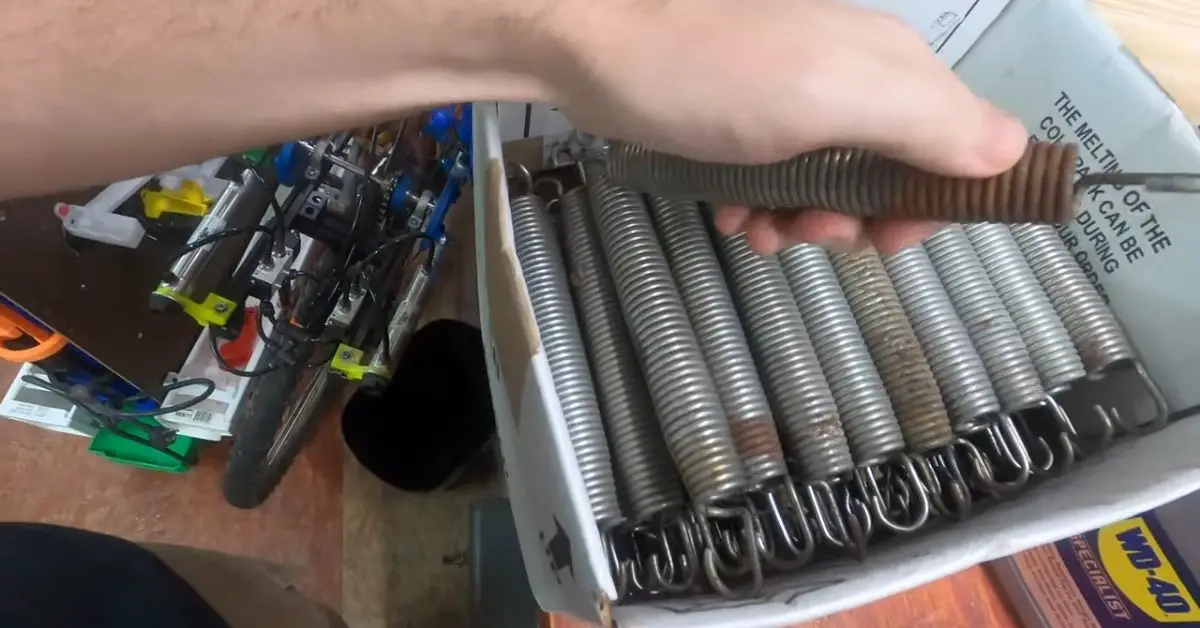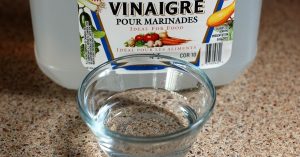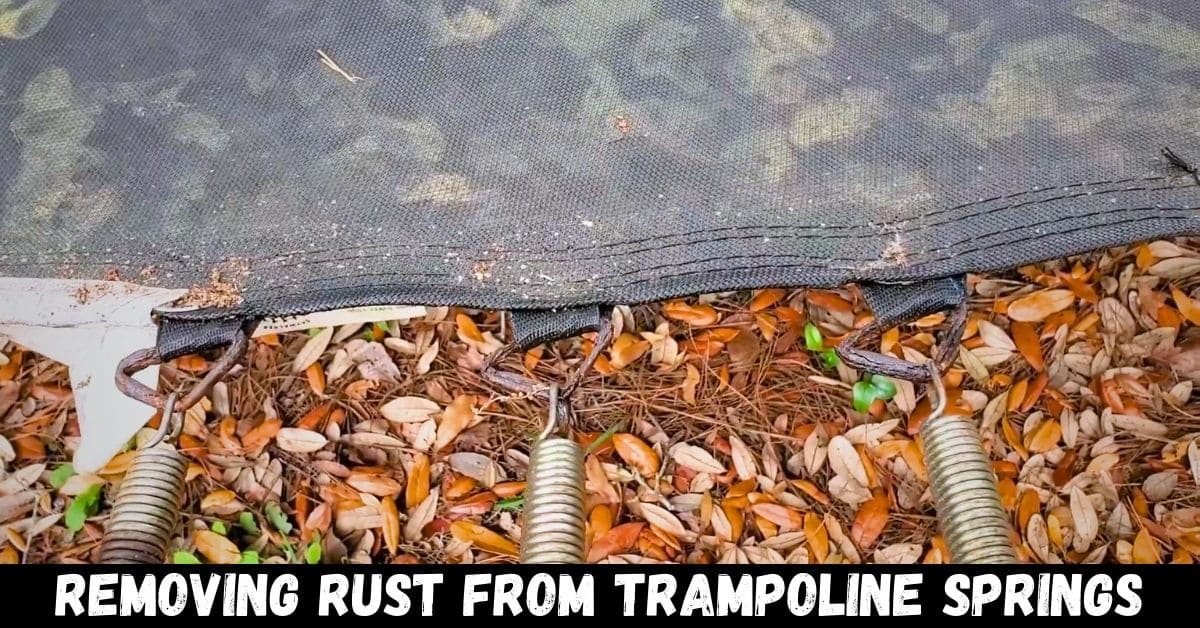If you have a rusted spring that needs restoration, there are several effective methods of how to remove rust from trampoline springs. Personally, I find that a mixture of vinegar and salt works wonders.
Alternatively, a commercial cleaner or a wire brush can also be used. However, the key is to ensure that every trace of rust is thoroughly eliminated before reinstalling the spring. Neglecting this step could lead to the spring breaking or failing prematurely.
Additionally, it’s crucial to remember to properly lubricate the spring after cleaning to enhance its durability. Taking these steps will help maintain the spring’s optimal performance and extend its lifespan.
Removing Rust from Trampoline Springs: To remove rust from trampoline springs, use a vinegar and salt mixture, a commercial cleaner, or a wire brush. Ensure complete rust removal and lubricate the springs for longevity.
Removing Rust from Trampoline Springs

If you see surface rust on your trampoline’s frame or springs, don’t worry. You can easily clean it off and restore the trampoline’s appearance.
This method is effective for surface rust, but if the rust has caused damage to the metal, you might need to replace that specific part or even the entire trampoline, depending on the extent of the damage.
Is steel wool a suitable option for removing rust from metal?
Steel wool can be effective in removing light surface rust from metal. However, it should be avoided on heavily rusted surfaces. It’s important to be cautious because steel wool can cause scratches and further damage, potentially promoting more rust.
Carefully evaluate the severity of the rust and consider if steel wool is the appropriate choice for your specific situation. It’s always recommended to test a small area first before proceeding with extensive use.
In some cases, alternative methods such as chemical rust removers or professional assistance may be more suitable for effectively treating heavily rusted surfaces.
How to prevent metal objects from rusting?
To prevent metal objects from rusting, a good method is to apply a protective layer of paint or sealant. Wax or oil-based rust inhibitors can also be used.
If the object is already rusted, clean and restore it before applying a protective coating. Keep in mind that some coatings work better at preventing rust, so it’s helpful to do some research before selecting one.
Is Coca-Cola effective in removing rust?
No, using Coca-Cola to remove rust won’t work and can actually make the problem worse. Coca-Cola is a fizzy drink that contains acids, which can cause the metal to corrode.
So, if you’re trying to remove rust from metal objects, it’s best to avoid using Coca-Cola. This idea is just a myth and has been proven false by many people.
Which chemical is effective in removing rust?

The most common chemical for rust removal is hydrochloric acid, but it can be hazardous and requires caution. Commercial rust removers use various chemicals, so carefully read the label before using any.
Another option is phosphoric acid, which is safer than hydrochloric acid and is found in many commercial rust removers. Phosphoric acid has advantages like being non-toxic, biodegradable, and not damaging the metal underneath.
Is it possible to remove rust without scrubbing?
If you want to remove rust without scrubbing, there are a few methods to consider. One option is using a commercial rust remover, which contains chemicals that dissolve rust.
Another approach is using a safer chemical called phosphoric acid, often found in commercial rust removers. Alternatively, you can use wax or an oil-based rust inhibitor, which forms a protective layer on the metal to prevent rust.
Lastly, you can paint or seal the metal object to provide a barrier against rust and maintain its appearance.
Is baking soda effective in removing rust?
Baking soda is ineffective in removing rust and can actually exacerbate the rusting process. When baking soda comes into contact with rust, it can form a compound known as sodium iron oxide, which can make the rust more difficult to remove in the future.
Therefore, it is advisable to avoid using baking soda as a rust removal method. Instead, opt for proven rust removal techniques such as vinegar and salt mixtures, commercial rust removers, or mechanical methods like wire brushing or sanding, depending on the severity of the rust and the type of metal involved.
Is bleach effective in removing rust?
Opinions are divided on whether bleach is effective for rust removal. Some people think it can work, but others believe it may harm the metal. To be safe, it’s best to test a small area before using bleach on a large metal object. If you decide to use bleach, dilute it with water and apply it carefully to the metal while taking necessary precautions.
Is vinegar a suitable option for removing rust?

Yes, vinegar is an effective method for removing rust and is commonly used for this purpose. You can create a mixture of vinegar and salt or use a wire brush to scrub away the rust.
After using vinegar, remember to rinse the object thoroughly as vinegar can be corrosive.
White vinegar, which contains 5% acetic acid, works well for rust removal from metal. If the object has heavy rust, apple cider vinegar with 6-8% acetic acid might be a better choice.
Before applying vinegar to the entire object, test it on a small, inconspicuous area of the metal. The main difference between white vinegar and apple cider vinegar is the cost and availability, with white vinegar being more affordable and easier to find.
What is the typical duration for vinegar to remove rust?
The time it takes for vinegar to remove rust varies based on how severe the rust is. Generally, a vinegar and salt mixture can handle light rust within a few minutes. For heavier rust, it may take more time and effort to remove. Using a wire brush to scrub away the rust can also be helpful.
Is WD-40 a suitable option for removing rust?
No, WD-40 is not designed to remove rust. It is a lubricant that can help prevent future rusting, but it cannot remove existing rust. If you want to get rid of rust from metal objects, it’s best to avoid using WD-40 and opt for a chemical or commercial rust remover instead.
While some people suggest using WD-40 as a last resort for rust removal on tools, it is not the recommended method.
Is alcohol effective in removing rust?
Through experience, it has been found that using alcohol to remove rust from metal objects is generally ineffective. Alcohol is not suitable for this task and can potentially damage the metal.
To ensure safe and effective rust removal, it is advised to avoid using alcohol and instead consider the previously mentioned methods.
These methods, such as vinegar and salt mixtures, commercial rust removers, or mechanical techniques like wire brushing or sanding, have proven to be more reliable in effectively removing rust from metal surfaces.
It is always important to prioritize the safety and preservation of the metal while tackling rust-related issues.
What are the common causes of rusting in trampoline springs?
Trampoline springs can rust due to several reasons. One common cause is being exposed to moisture for prolonged periods. When springs stay wet, they are more likely to rust.
The type of metal used in the springs can also play a role, as some metals are more susceptible to rust. Additionally, improper storage in a damp environment can contribute to rust formation over time.
Is toothpaste effective in removing rust?
Using toothpaste to remove rust carries a risk because it often contains abrasives that can harm the metal. If you decide to try toothpaste, test it on a small area to ensure it doesn’t cause damage. After applying toothpaste, remember to thoroughly rinse the object as toothpaste can be corrosive.
Is it okay to use steel wool to get rid of rust from metal?
Yes, you can use steel wool to remove light rust from metal, but be careful not to use it on heavily rusted areas. Steel wool can create scratches on the metal, which may make rusting worse.
So, consider how severe the rust is and if steel wool is the best choice for your situation. It’s essential to use the right method to remove rust effectively without causing any damage to the metal.
What makes certain trampoline frames resistant to rust?
High-quality trampolines have a rust-resistant feature achieved through a process called hot-dipped galvanization. During manufacturing, the metal frame is immersed in hot zinc, which creates a strong bond with the metal rather than just coating it like paint.
This protective zinc layer covers both the inside and outside of the metal tubes. As a result, oxygen cannot reach the iron particles, preventing rust formation.
It’s crucial for the coating to be applied to both sides of the frame since rain, humidity, and water entering through spring holes and screws can affect the inside of the frame as well.
Rusty springs despite trying all methods, What now?
If the methods mentioned earlier don’t work, you might want to consider getting help from a professional to fix the rusty springs. Professionals have special chemicals and tools that can remove even the toughest rust stains. But keep in mind that this option can be expensive, so think about it carefully before deciding.
Removing rust from springs can be a bit tricky, and if you’re not careful, you could accidentally damage the metal.
Don’t worry if you see rust on your trampoline springs; there are various methods you can try to remove it. Start with vinegar and salt, but test them in a hidden area first. If that doesn’t work, you can use a wire brush or a commercial rust remover.
If none of these methods work, consider taking the springs to a professional who has the right chemicals and equipment to handle even the most stubborn rust stains.
After Rust Removal
After removing rust from the trampoline springs, make sure to inspect and clean the springs thoroughly. Apply lubricant for smooth movement and consider using a protective coating.
Check the trampoline’s overall condition and implement regular maintenance. Consider using a weatherproof cover when not in use.
Educate users about safety guidelines and encourage safe jumping practices. With these steps, your trampoline will stay rust-free and safe for everyone to enjoy.
Maintenance Tips
Here are some maintenance tips:
Regular Inspection of Springs:
It is important to conduct routine inspections of the trampoline springs. Check for any visible signs of rust, such as orange or brown discoloration, and examine the springs for cracks, breaks, or weakening.
These inspections should be done at least once a month or more frequently if the trampoline is heavily used or exposed to harsh weather conditions. Promptly address any rust or damage to prevent further deterioration and potential safety hazards.
Keep Trampoline Clean and Debris-Free:
Regular cleaning of the trampoline is essential to prevent rust. Remove leaves, dirt, and other debris from the trampoline surface using a soft brush or broom. Use a mild detergent mixed with water to clean the frame, springs, and other metal components.
Thoroughly rinse with clean water, ensuring all soap residue is removed. By maintaining a clean trampoline, you can prevent the accumulation of moisture and debris that may accelerate rusting.
Apply Rust Inhibitor Spray or Lubricant:
Utilize a rust inhibitor spray or a suitable lubricant designed for outdoor use and metal surfaces. Follow the instructions provided by the manufacturer for application. Pay particular attention to the springs and other vulnerable areas.
Ensure complete coverage and even distribution of the spray or lubricant. This protective coating will create a barrier against moisture and oxidation, effectively preventing rust formation and extending the lifespan of the springs.
Proper Storage During Off-Season or Bad Weather:
When the trampoline is not in use or during unfavorable weather conditions, it is crucial to store it appropriately. If possible, disassemble the trampoline following the manufacturer’s instructions.
Clean and thoroughly dry all components before storing them in a dry and covered area. If disassembly is not feasible, use a weatherproof cover to protect the trampoline from rain, snow, and direct sunlight.
Avoid leaving the trampoline exposed to extreme weather conditions for prolonged periods as this can accelerate rusting and deterioration.
By implementing these detailed maintenance tips, you can effectively prevent rust, promote the longevity of your trampoline, and ensure a safe and enjoyable experience for users.
Safety Precautions
Safety Precautions for Removing Rust from Trampoline Springs:
- Wear protective gear: Gloves, safety goggles, and a dust mask.
- Work on a stable surface.
- Inspect the trampoline for damage before starting.
- Use mild rust removal methods first.
- Store chemicals safely, away from children and pets.
- Avoid abrasive tools on galvanized springs.
- Be gentle and avoid excessive force.
- Rinse and dry thoroughly after rust removal.
- Dispose of chemicals properly.
- Seek professional help if needed.
FAQs:
Q:1 How do you clean trampoline springs?
To clean trampoline springs, you can create a paste by mixing half a cup of salt with the juice of a couple of limes. Remove the spring from the trampoline and apply the paste to the rusted areas.
Allow it to sit for a few hours for optimal effectiveness. Next, use an old toothbrush to scrub the spring clean. Rinse it thoroughly and let it dry completely before reattaching it to the trampoline. This method can help remove rust and restore the springs to a better condition.
Q:2 What should you spray rusty springs with?
RustSeal is highly valued for its exceptional durability and flexibility. These qualities make it an excellent coating for effectively halting rust on both coil springs and leaf springs. Its long-lasting protection helps to prevent further corrosion and maintains the optimal performance of the springs.
Q:3 How do you restore a rusty spring?
I purchased a pint of store-brand vinegar from Sainsbury’s for 69p to patch test one spring. I submerged half of the spring in vinegar overnight, ensuring maximum contact with the liquid. To my delight, using wire wool to rub it down the next morning was successful in removing the rust.
Q:4 How can I prevent my trampoline legs from rusting?
To prevent early rusting, line the ground with thick PVC or carpet beneath the trampoline, secure it firmly, and anchor the trampoline to avoid slipping. These precautions minimize moisture exposure and prolong the trampoline’s lifespan.
Q:5 Is it advisable to use WD-40 on trampoline springs?
If you notice noise coming from your trampoline after some use, try lifting the pads around the trampoline and apply a spray of WD40 or a similar product to the frame joints and springs.
Be sure to wipe off any excess lubricant to prevent dust from sticking to the trampoline frame. This can help reduce the noise and ensure smooth operation.
Conclusion:
In conclusion, removing rust from trampoline springs requires proactive steps to restore their condition and prevent further corrosion. Begin by inspecting the springs regularly, looking for signs of rust or damage. When rust is detected, various methods can be employed.
Vinegar and salt mixtures or commercial rust removers can effectively remove surface rust. For more stubborn rust, using a wire brush or steel wool may be necessary.
It is crucial to ensure complete rust removal before reinstallation to prevent potential breakage or premature failure. After cleaning, applying a rust inhibitor or lubricant can help protect the springs and extend their lifespan.
Additionally, taking preventive measures such as proper storage during off-seasons, regular cleaning, and addressing rust promptly will contribute to minimizing rust formation.
By implementing these practices, trampoline springs can be maintained in optimal condition, ensuring a safe and enjoyable bouncing experience for years to come.
We hope you will be well aware of removing rust from trampoline springs, after reading this comprehensive article. If you have any questions, feel free to comment below!

